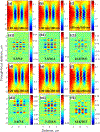Fidelity test for through-focus or volumetric type of optical imaging methods
- PMID: 30114170
- PMCID: PMC6159218
- DOI: 10.1364/OE.26.019100
Fidelity test for through-focus or volumetric type of optical imaging methods
Abstract
Rapid increase in interest and applications of through-focus (TF) or volumetric type of optical imaging in biology and other areas has resulted in the development of several TF image collection methods. Achieving quantitative results from images requires standardization and optimization of image acquisition protocols. Several standardization protocols are available for conventional optical microscopy where a best-focus image is used, but to date, rigorous testing protocols do not exist for TF optical imaging. In this paper, we present a method to determine the fidelity of the TF optical data using the TF scanning optical microscopy images.
Conflict of interest statement
Disclosures
The author declares no conflicts of interest related to this article.
Figures













Similar articles
-
Through-focus or volumetric type of optical imaging methods: a review.J Biomed Opt. 2018 Jul;23(7):1-10. doi: 10.1117/1.JBO.23.7.070901. J Biomed Opt. 2018. PMID: 29981229 Free PMC article. Review.
-
Lateral movement and angular illuminating non-uniformity corrected TSOM image using Fourier transform.Opt Express. 2020 Mar 2;28(5):6294-6305. doi: 10.1364/OE.382748. Opt Express. 2020. PMID: 32225881
-
Quantitative reconstruction of time-varying 3D cell forces with traction force optical coherence microscopy.Sci Rep. 2019 Mar 11;9(1):4086. doi: 10.1038/s41598-019-40608-4. Sci Rep. 2019. PMID: 30858424 Free PMC article.
-
In vivo volumetric fluorescence sectioning microscopy with mechanical-scan-free hybrid illumination imaging.Biomed Opt Express. 2016 Sep 12;7(10):3968-3978. doi: 10.1364/BOE.7.003968. eCollection 2016 Oct 1. Biomed Opt Express. 2016. PMID: 27867708 Free PMC article.
-
Applications and challenges of digital pathology and whole slide imaging.Biotech Histochem. 2015 Jul;90(5):341-7. doi: 10.3109/10520295.2015.1044566. Epub 2015 May 15. Biotech Histochem. 2015. PMID: 25978139 Review.
References
-
- Azaripour A, Lagerweij T, Scharfbillig C, Jadczak AE, Swaan B. v. d., Molenaar M, Waal R. v. d., Kielbassa K, Tigchelaar W, Picavet DI, Jonker A, Hendrikx EML, Hira VVV, Khurshed M, and Noorden CJFV, “Three-dimensional histochemistry and imaging of human gingiva,” Sci Rep-Uk 8, 1647 (2018). - PMC - PubMed
-
- Katona G, Szalay G, Maák P, Kaszás A, Veress M, Hillier D, Chiovini B, Vizi ES, Roska B, and Rózsa B, “Fast two-photon in vivo imaging with three-dimensional random-access scanning in large tissue volumes,” Nat Methods 9, 201 (2012). - PubMed
Grants and funding
LinkOut - more resources
Full Text Sources
Other Literature Sources
Miscellaneous

